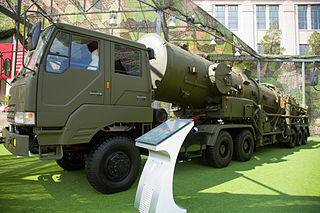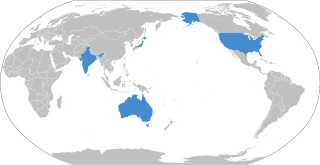
The People's Liberation Army Navy, also known as the People's Navy, PLA Navy or simply Chinese Navy, is the naval warfare branch of the People's Liberation Army, the military of the People's Republic of China. As of 2024, it is the second-largest navy in the world in terms of total displacement, and the largest navy per number of ships in active service.

The Republic of China Armed Forces are the armed forces of the Republic of China (ROC) that once ruled Mainland China and now currently restricted to its territorial jurisdictions of Taiwan, Penghu, Kinmen and Matsu Islands. They consist of the Army, Navy, Air Force and Military Police Force. The military is under the civilian control of the Ministry of National Defense, a cabinet-level agency overseen by the Legislative Yuan.

The East China Sea is a marginal sea of the Western Pacific Ocean, located directly offshore from East China. China names the body of water along its eastern coast as "East Sea" due to direction, the name of "East China Sea" is otherwise designated as a formal name by International Hydrographic Organization (IHO) and used internationally.

The Republic of China Navy is the maritime branch of the Republic of China Armed Forces (ROCAF).

Leapfrogging, also known as island hopping, was an amphibious military strategy employed by the Allies in the Pacific War against the Empire of Japan during World War II. The key idea was to bypass heavily fortified enemy islands instead of trying to capture every island in sequence en route to a final target. The reasoning was that those islands could simply be cut off from their supply chains rather than needing to be overwhelmed by superior force, thus speeding up progress and reducing losses of troops and materiel.

The United States foreign policy toward the People's Republic of China originated during the Cold War. At that time, the U.S. had a containment policy against communist states. The leaked Pentagon Papers indicated the efforts by the U.S. to contain China through military actions undertaken in the Vietnam War. The containment policy centered around an island chain strategy. President Richard Nixon's China rapprochement signaled a shift in focus to gain leverage in containing the Soviet Union. Formal diplomatic ties between the U.S. and China were established in 1979, and with normalized trade relations since 2000, the U.S. and China have been linked by closer economic ties and more cordial relations. In his first term as U.S. president, Barack Obama said, "We want China to succeed and prosper. It's good for the United States if China continues on the path of development that it's on".

Nanshin-ron was a political doctrine in the Empire of Japan that stated that Southeast Asia and the Pacific Islands were Japan's sphere of interest and that their potential value to the Empire for economic and territorial expansion was greater than elsewhere.

The Dong-Feng 21 (DF-21; NATO reporting name CSS-5 - Dong-Feng is a two-stage, solid-fuel rocket, single-warhead medium-range ballistic missile in the Dong Feng series developed by China Changfeng Mechanics and Electronics Technology Academy. Development started in the late 1960s and was completed around 1985–86, but it was not deployed until 1991. It was developed from the submarine-launched JL-1 missile, and is China's first solid-fuel land-based missile. The U.S. Department of Defense in 2008 estimated that China had 60-80 missiles and 60 launchers; approximately 10-11 missiles can be built annually.

China Coast Guard (CCG) is the maritime security, search and rescue, and law enforcement service branch of the People's Armed Police of China.
The Andaman and Nicobar Command (ANC) is a integrated tri-services command of the Indian Armed Forces, based at Port Blair in the Andaman and Nicobar Islands, a Union Territory of India. It was created in 2001 to safeguard India's strategic interests in Southeast Asia and the Strait of Malacca by increasing rapid deployment of military assets in the region. It provides logistical and administrative support to naval ships which are sent on deployment to East Asia and the Pacific Ocean.
The String of Pearls is a geopolitical hypothesis proposed by United States political researchers in 2004. The term refers to the network of Chinese military and commercial facilities and relationships along its sea lines of communication, which extend from the Chinese mainland to Port Sudan in the Horn of Africa. The sea lines run through several major maritime choke points such as the Strait of Mandeb, the Strait of Malacca, the Strait of Hormuz, and the Lombok Strait as well as other strategic maritime centres in Somalia and the littoral South Asian countries of Pakistan, Sri Lanka, Bangladesh, and the Maldives.
U.S. President Barack Obama's East Asia Strategy (2009–2017), also known as the Pivot to Asia, represented a significant shift in the foreign policy of the United States since the 2010s. It shifted the country's focus away from the Middle Eastern and European sphere and allowed it to invest heavily and build relationships in East Asian and Southeast Asian countries, especially countries which are in close proximity to the People's Republic of China (PRC) either economically, geographically or politically to counter its rise as a rival superpower.
AirSea Battle is an integrated battle doctrine that forms a key component of the military strategy of the United States. The doctrine became official in February 2010, and was renamed to Joint Concept for Access and Maneuver in the Global Commons (JAM-GC) in 2015.

Territorial disputes in the South China Sea involve conflicting island and maritime claims in the South China Sea by several sovereign states, namely the People's Republic of China (PRC), Taiwan, Brunei, Malaysia, the Philippines, Vietnam and Indonesia. The disputes involve the islands, reefs, banks, and other features of the region, including the Spratly Islands, Paracel Islands, Scarborough Shoal, and various boundaries in the Gulf of Tonkin. The waters near the Indonesian Natuna Islands, which some regard as geographically part of the South China Sea, are disputed as well.

The Quadrilateral Security Dialogue (QSD), commonly known as the Quad, it is a strategic security dialogue between Australia, India, Japan and the United States that is maintained by talks between member countries. The dialogue was initiated in 2007 by Japanese Prime Minister Shinzo Abe, with the support of Australian Prime Minister John Howard, Indian Prime Minister Manmohan Singh and U.S. Vice President Dick Cheney. The dialogue was paralleled by joint military exercises of an unprecedented scale, titled Exercise Malabar. The diplomatic and military arrangement was widely viewed as a response to increased Chinese economic and military power.
The island chain strategy is a strategic maritime containment plan first conceived by American foreign policy statesman John Foster Dulles in 1951, during the Korean War. It proposed surrounding the Soviet Union and China with naval bases in the West Pacific to project power and restrict sea access.

Japan participated in World War II from 1939 to 1945 as a member of the Axis and encapsulates a significant period in the history of the Empire of Japan, marked by significant military campaigns and geopolitical maneuvers across the Asia-Pacific region. Spanning from the early 1930s to 1945, this tumultuous era witnessed Japan's expansionist policies and aggressive military actions, including the invasion of the Republic of China, the annexation of French Indochina, and the subsequent incursion into British India. The Pacific War, a major theater of World War II, further intensified Japan's engagements, leading to significant confrontations with Allied forces in the Pacific Ocean. Ultimately, the conflict culminated in the Surrender of Japan, a momentous event that marked the end of hostilities and reshaped the global landscape.
Geostrategy in Taiwan refers to the foreign relations of Taiwan in the context of the geography of Taiwan. Taiwan is an island country in East Asia, while it is also located at the center of the first island chain and commands the busy traffic of Taiwan Strait and Bashi Channel.

The Maritime Militia, also called the Fishing Militia, is one of the three forces, next to the China Coast Guard (CCG) and the People's Liberation Army Navy (PLAN), used in maritime operations by the People’s Republic of China (PRC).
Cabbage tactics is a militarily swarming and overwhelming tactic used by the People's Liberation Army Navy to seize control of islands. It is done by surrounding and wrapping the island in successive layers of Chinese naval ships, China Coast Guard ships, and fishing boats and cut off the island from outside support.














